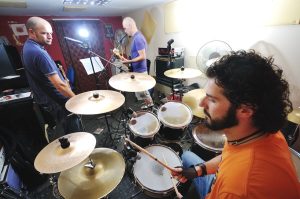The best way to soundproof a basement ceiling
An unfinished basement is a great place to weather severe storms and store seasonal items or family heirlooms, but finish it right, and you can double the amount of livable space in your place. Finishing your basement delivers lots of benefits, but making it as comfortable as the rest of the house requires attention to detail.
Whether you’re creating a quiet space to binge your favorite series or adding bedrooms to accommodate your growing family, the last thing you want to deal with is noise. Learning how to soundproof a basement ceiling is one of those details that can make or break your newfound square footage.
If you’re going to be spending any real time down there, you’ll want to make sure you do something to tackle the transmission of any disruptive sounds from the upstairs to the downstairs. Don’t you think dealing with noise in the basement is that important? Think again.
Why soundproof a basement ceiling?
The main floor is the main living area in the home, and that means people are walking around pretty regularly. All those footsteps create impact sounds that will travel through the floor and into the living space below, disrupting both your beauty sleep and your ability to relax on movie night. Pair those impact sounds with the fact that noisy pipes and HVAC ductwork generally runs between the basement ceiling and the floor above it, and you’ve got some great reasons to create a ceiling sound barrier in your basement.
Basement soundproofing fundamentals
There are all kinds of ways to soundproof different surfaces in rooms, and they all work wonders with certain kinds of spaces and sound waves. The correct choice comes down to the specific type of room you’re dealing with and the types of sounds that are giving you trouble. When you want to soundproof a basement ceiling, there are a couple of main points of focus that will deliver the biggest bang for your buck.
Dealing with footfalls
The most common noise you’ll probably be dealing with in any basement is the sound of people walking above you. Every time someone’s foot strikes the floor, it can create sounds directly related to the soles of shoes striking the floor, but it can also cause movement in the floor materials themselves, causing creaking, cracking, and chirping noise in basements that aren’t treated for it. We deal with this type of noise by decoupling materials and adding mass and density to the barrier between the two levels.
Dealing with noisy utility equipment
The second source of prevalent basement noise is going to be those pipes and ducts that run above your head. They emanate sounds whenever water or air passes through them. These sounds aren’t all that loud, but when added to the other sounds of life happening on two floors, they add up. When we soundproof a basement ceiling, addressing the pipes and ductwork is a must.
Dealing with airborne noise from upstairs
Airborne noises are caused by things like conversations, televisions, or radios being played on another floor. Some airborne noises will pass directly through the floor, but that isn’t the only way they pass from one level to the next. Many basements have open stairwells that allow sound waves to pass from one level to the next, unobstructed. If you want to block them out, you’ll have to get a little creative with your soundproofing plan.
How to soundproof exposed basement ceilings
If the basement ceiling is completely unfinished when you start the project, you have a lot more options without getting yourself into a huge undertaking. If you’ve got to remove existing drywall first, it’s going to become a much messier and more expensive project. More on that later, but first, we’ll start by looking at the process of creating a soundproof basement ceiling without drywall.
Seal any gaps or cracks
Most homes aren’t constructed to be airtight between levels, so anywhere you can see light passing from one level to another is a place where sound waves can find a way through. When we soundproof a basement ceiling, sealing those spaces is the first step. Creating a barrier will mean fewer waves pass through, and fewer waves need to be dealt with.
Fix your problem with footfalls
Since the loudest sounds you experience will likely come from people walking around upstairs, it’s a good idea to minimize the amount of footfall vibration that passes into the structure below. Rolling out some mass loaded vinyl or acoustic flooring underlay on top of the subfloor will absorb a good deal of those impact sounds before they ever reach the trusses below.
Deal with pipes and ductwork
As we touched on earlier, pipes and ductwork can contribute enough low level noise to become a nuisance. Any time you turn on a faucet somewhere in your house, the entire length of the pipes attached to it are capable of creating vibrations that can fill entire spaces. The same thing can happen when your furnace fires up. When pipes and ductwork vibrate, everything attached to them vibrates, meaning you’ve got a significant source of sound. Silencing them will contribute to a more comfortable and stress free ambiance for your new basement living spaces.
The way we get there is by adding insulation and decoupling or separating them from the other surfaces they come in contact with. This step is tough if your ceiling is sealed, but it’s a breeze when soundproofing an exposed joist ceiling.
Wrapping your pipes and ductwork with an insulating layer and mounting them with clips that decouple them from the surrounding structure prevents those vibrations from transferring to other materials. It also absorbs a good deal of the sound waves that are produced by the pipes and ductwork themselves before they ever reach our ears.
Add insulation
Once you’ve taken care of the pipes and ductwork, you’ll want to add insulation to all the empty space between your home’s levels. Any insulation will provide some value when insulating basement ceilings for sound, but if you’re going to the trouble to soundproof a basement ceiling, you’ll want to choose insulation that absorbs a good deal of sound.
The best sound insulation for ceilings is going to be something that has more mass and density than traditional thermal insulation. Remember, we’re insulating against sound transfer, not heat transfer. That added mass will make it harder for vibrations to penetrate all the way to the other side.
Finish the ceiling
When the work of insulating and decoupling the materials is complete, you’ll need to finish your ceiling, so it looks great and provides an additional defense against any sound waves or vibrations that make their way through the barrier you’ve created.
You could go with a drop ceiling fitted with acoustical panels, but most basements already have fairly low ceilings, and reducing the height any further may make the room feel cramped. The most popular solution is to finish the ceiling with drywall.
Choosing your drywall
Drywall comes in a variety of different thicknesses. Thinner drywall is cheaper but doesn’t add the mass necessary to keep sound transmission down. You’re better off going with thick drywall. Choosing ⅝” drywall more than doubles the mass of its ¼” counterpart, so don’t skimp on this important piece of the puzzle.
You don’t need to limit yourself to a single layer, either. Apply green glue or mass loaded vinyl to the first layer before adding the second, and you’ll absorb those remaining vibrations before they reach the final layer. You’ll also cut sound transmission substantially.
Treat the stairwell
Now that we’ve added mass and density to the ceiling and sealed it all up, we will want to address the noise that makes its way downstairs via the open stairwell. Since most of the sound that enters this space isn’t coming through the structure, soundproofing basement walls probably isn’t necessary here. Acoustical treatment is a much more efficient option for tackling it.
Get yourself some fabric wrapped acoustic panels to serve as stairway art. They’ll absorb a good amount of your unwanted sound waves before they ever reach the basement. Fabric wrapped acoustic panels come in so many colors and prints that you’re sure to find something that adds a lot more than sound control to your stairwell walls. If none of the available colors or patterns fit your decor, you can always print original art or photos on them, turning the space into a personal gallery.
How to soundproof basement ceilings that are finished
As you may have guessed, soundproofing a basement ceiling that is already finished looks a lot like soundproofing an unfinished basement ceiling, but doing it all requires a lot of demolition, mess, and added cost. If you want to reduce sound transmission through your ceiling without getting into a huge project, there are still some great solutions for you.
Add drywall to the ceiling
You don’t need to be starting from scratch to add a layer of drywall to the one you currently have. Roll out mass loaded vinyl or green glue between the layers to ensure you get substantial added mass and density without the need for a lot of demo and cleanup. Make sure to overlap your seams, so you don’t have any weak points in the span.
Shore up the floor
Depending on the state of the floor above you, you can add some mass there too. If you’re in the market for a new floor, roll out some mass loaded vinyl or acoustic flooring underlay before installing your carpeting, hardwoods, or whatever flooring material you’ve decided to go with. You’ll stop a lot of impact sounds from making it to the basement.
If you’ve got beautiful hardwoods that you aren’t planning on getting rid of anytime soon, consider throwing down some area rugs and runners in high traffic areas. You’ll reduce the force of the impact and help with some of the impact noise.
Pros soundproof a basement ceiling better
Learning how to reduce noise from basement bedrooms and family rooms isn’t rocket science, but it does take some technical knowledge and planning. There are so many effective things you can do to cut down on the sound passage from your main floor to the basement you may be wondering if you need it all. It’s a good question to ask yourself because the price difference between the level you find acceptable and a total soundproofing solution can be substantial. Consulting with professionals before you soundproof a basement ceiling will ensure you achieve the results you’re after and complete your project on budget.

















Add comment
You must be logged in to post a comment.